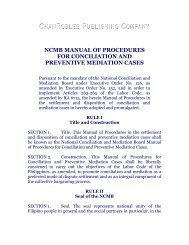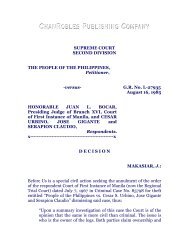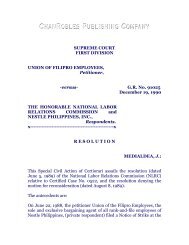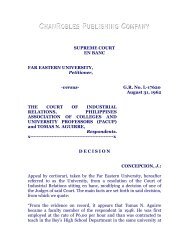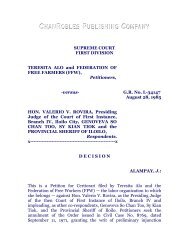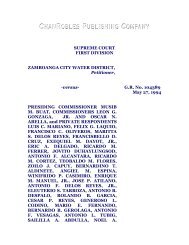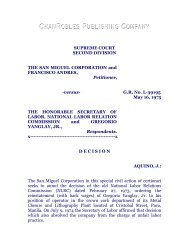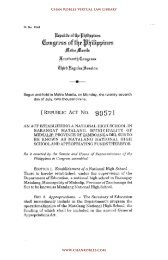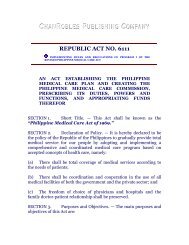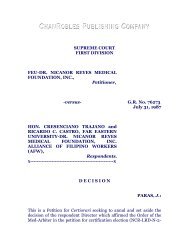IBM Philippines, Inc. vs. NLRC - Chan Robles and Associates Law ...
IBM Philippines, Inc. vs. NLRC - Chan Robles and Associates Law ...
IBM Philippines, Inc. vs. NLRC - Chan Robles and Associates Law ...
You also want an ePaper? Increase the reach of your titles
YUMPU automatically turns print PDFs into web optimized ePapers that Google loves.
SUPREME COURT<br />
SECOND DIVISION<br />
<strong>IBM</strong> PHILIPPINES, INC., VIRGILIO L.<br />
PEÑA, <strong>and</strong> VICTOR V. REYES,<br />
Petitioners,<br />
-versus- G.R. No. 117221<br />
April 13, 1999<br />
NATIONAL LABOR RELATIONS<br />
COMMISSION <strong>and</strong> ANGEL D. ISRAEL,<br />
Respondents.<br />
x----------------------------------------------------x<br />
D E C I S I O N<br />
MENDOZA, J.:<br />
This is a Petition for Certiorari to set aside the Decision, [1] dated April<br />
15, 1994, of the National Labor Relations Commission (<strong>NLRC</strong>) finding<br />
private respondent to have been illegally dismissed <strong>and</strong> ordering his<br />
reinstatement <strong>and</strong> the payment of his wages from August 1991 until<br />
he is reinstated. chanroblespublishingcompany<br />
Petitioner <strong>IBM</strong> <strong>Philippines</strong>, <strong>Inc</strong>. (<strong>IBM</strong>) is a domestic corporation<br />
engaged in the business of selling computers <strong>and</strong> computer services.<br />
Petitioners Virgilio L. Peña <strong>and</strong> Victor V. Reyes were ranking officers<br />
of <strong>IBM</strong> during the period pertinent to this case.
On April 1, 1975, private respondent Angel D. Israel commenced<br />
employment with <strong>IBM</strong> as Office Products Customer Engineer. For the<br />
next sixteen (16) years, he occupied two other positions in the<br />
company, [2] received numerous awards, [3] <strong>and</strong> represented the<br />
company in various seminars <strong>and</strong> conferences in <strong>and</strong> out of the<br />
company. [4] chanroblespublishingcompany<br />
On February 1, 1990, private respondent was assigned to the team<br />
supervised by petitioner Reyes. chanroblespublishingcompany<br />
On June 27, 1991, petitioner Reyes h<strong>and</strong>ed a letter to private<br />
respondent informing the latter that his employment in the company<br />
was to be terminated effective July 31, 1991 on the ground of habitual<br />
tardiness <strong>and</strong> absenteeism. The letter states, thus: chanroblespublishingcompany<br />
Mr. Angel D. Israel<br />
Present<br />
Dear Angel,<br />
June 27, 1991<br />
This refers to our previous discussion regarding your habitual<br />
absences <strong>and</strong> tardiness the last of which was on June 26, 1991.<br />
Your records will attest to the fact that on several occasions,<br />
your attention has been called to your habitual tardiness <strong>and</strong><br />
non-observance of st<strong>and</strong>ing office procedures regarding<br />
attendance. Despite several opportunities given to you, you<br />
cannot seem to reform your ways <strong>and</strong> attitude on the matter of<br />
attendance. Considering that we are a service-oriented<br />
company, you can appreciate that we cannot allow such a<br />
situation to continue lest we put the best interest of the<br />
Company in jeopardy. chanroblespublishingcompany<br />
Much to our regret, therefore, pleased (sic) be advised that the<br />
Company is terminating your employment effective July 31,<br />
1991.
You are requested to report to Personnel Department at your<br />
earliest convenience for the settlement of any money or benefits<br />
due you. chanroblespublishingcompany<br />
cc: L.L. Abano<br />
Very truly yours,<br />
(Sgd) V. V. REYES<br />
Business Manager<br />
Alleging that his dismissal was without just cause <strong>and</strong> due process,<br />
private respondent filed a complaint with the Arbitration Branch of<br />
the Department of Labor <strong>and</strong> Employment (DOLE) on July 18, 1991.<br />
In his position paper filed on September 6, 1991, he claimed that he<br />
was not given the opportunity to be heard <strong>and</strong> that he was summarily<br />
dismissed from employment based on charges which had not been<br />
duly proven. [5] chanroblespublishingcompany<br />
Petitioners denied private respondent's claims. It was alleged that<br />
several conferences were held by the management with private<br />
respondent because of the latter's unsatisfactory performance in the<br />
company <strong>and</strong> he was given sufficient warning <strong>and</strong> opportunity to<br />
"reform <strong>and</strong> improve his attitude toward attendance," [6] but to their<br />
regret, he never did. It was alleged that private respondent was<br />
constantly told of his poor attendance record <strong>and</strong> inefficiency through<br />
the company's internal electronic mail (e-mail) system. According to<br />
petitioners, this system allows paperless or "telematic" [7]<br />
communication among <strong>IBM</strong> personnel in the company offices here<br />
<strong>and</strong> abroad. An employee is assigned a "User ID" <strong>and</strong> the<br />
corresponding password is provided by the employee himself <strong>and</strong>,<br />
theoretically, known only to him. Employees are then expected to<br />
turn on their computers everyday, "log in" to the system by keying in<br />
their respective IDs <strong>and</strong> passwords in order to access <strong>and</strong> read the<br />
messages sent to <strong>and</strong> stored in the computer system. To reply, an<br />
employee types in or encodes his message-response <strong>and</strong> sends the<br />
same to the intended recipient, also via the computer system. The<br />
system automatically records the time <strong>and</strong> date each message was<br />
sent <strong>and</strong> received, including the identification of the sender <strong>and</strong>
eceiver thereof. All messages are recorded <strong>and</strong> stored in computer<br />
disks. [8] chanroblespublishingcompany<br />
Attached to petitioners' position paper were copies of print-outs of<br />
alleged computer entries/messages sent by petitioner Reyes to private<br />
respondent through <strong>IBM</strong>'s internal computer system. The following is<br />
a summary of the contents of the print-outs which mostly came from<br />
petitioner Reyes' computer: chanroblespublishingcompany<br />
(a) Private respondent was admonished when he would miss<br />
out on meetings with clients <strong>and</strong> failed to attend to<br />
important accounts, such as that of Hella <strong>Philippines</strong>; [9]<br />
(b) Petitioner Reyes conducted consultations with private<br />
respondent concerning the latter's work habits; [10]<br />
(c) A new policy of requiring employees to be at the office at<br />
8:30 a.m. every morning was adopted <strong>and</strong> employees were<br />
no longer allowed to sign out of the office by phone; [11]<br />
(d) Petitioner Reyes would type into his computer the records<br />
of the security guard which reflect private respondent's<br />
daily tardiness <strong>and</strong> frequent absences; [12] chanroblespublishingcompany<br />
(e) Private respondent was admonished when he failed to<br />
respond to instructions from his superiors; [13]<br />
(f) <strong>IBM</strong> Australia, contacted by Hella Australia, once asked<br />
about the reported lack of attention given to Hella<br />
<strong>Philippines</strong>. [14] Private respondent directly answered <strong>IBM</strong><br />
Australia, through telematic memo, <strong>and</strong> reported that Hella<br />
<strong>Philippines</strong> was deferring its computer plan <strong>and</strong> decided to<br />
use micros in the meantime; [15] chanroblespublishingcompany<br />
(g) The said response was denied by Hella Australia which<br />
later made it clear that it would be buying "anything but<br />
<strong>IBM</strong>"; [16] <strong>and</strong><br />
(h) While private respondent showed some improvement after<br />
consultations where he allegedly admitted his
shortcomings, petitioner Reyes reported that he (private<br />
respondent) would eventually slide back to his old ways<br />
despite constant counseling <strong>and</strong> repeated warnings that he<br />
would be terminated if he would not improve his work<br />
habits. [17] chanroblespublishingcompany<br />
Through these computer print-outs calling private respondent's<br />
attention to his alleged tardiness <strong>and</strong> absenteeism, petitioner sought<br />
to prove that private respondent was sufficiently notified of the<br />
charges against him <strong>and</strong> was guilty thereof because of his failure to<br />
deny the said charges. chanroblespublishingcompany<br />
On March 13, 1992, the labor arbiter rendered a decision finding<br />
private respondent to have been terminated for cause <strong>and</strong> accordingly<br />
dismissing the complaint. Considering, however, the ground for<br />
termination as well as private respondent's long record of service to<br />
the company, the arbiter ordered the award of separation pay at the<br />
rate equivalent to one-half (½) month salary for every year of service.<br />
The dispositive portion of the decision reads — chanroblespublishingcompany<br />
WHEREFORE, judgment is hereby rendered in this case<br />
declaring respondent <strong>IBM</strong> Phils., <strong>Inc</strong>. not guilty of the charge of<br />
illegal dismissal. However, respondent company is directed to<br />
pay complainant Israel the sum of Two Hundred Forty Eight<br />
Thous<strong>and</strong> (P248,000.00) as separation pay. All other claims<br />
are denied for lack of merit. chanroblespublishingcompany<br />
It appears, however, that prior to the release of the labor<br />
arbiter's decision at 11:21 a.m. on March 26, 1992, private<br />
respondent had filed a "Manifestation And Motion To Admit<br />
Attached New Evidence For The Complainant" which was<br />
received by the Arbitration Branch at 10:58 a.m. of the same<br />
day. The evidence consisted of private respondent's Daily Time<br />
Records (DTRs) for the period June 1, 1990 to August 31, 1990<br />
<strong>and</strong> pay slips for the period January 1990 to June 1991 showing<br />
that private respondent did not incur any unexcused absences,<br />
that he was not late on any day within the period <strong>and</strong> that no<br />
deduction was made from his salary on account of tardiness or<br />
absences. chanroblespublishingcompany
Private respondent appealed to the <strong>NLRC</strong> which, on April 15,<br />
1994, reversed the labor arbiter's decision <strong>and</strong> found private<br />
respondent's dismissal illegal. The <strong>NLRC</strong> ruled: (1) that the<br />
computer print-outs which petitioners presented in evidence to<br />
prove that private respondent's office attendance was poor were<br />
insufficient to show that the latter was guilty of habitual<br />
absences <strong>and</strong> tardiness; <strong>and</strong> (2) that private respondent was not<br />
heard in his defense before the issuance of the final notice of<br />
dismissal. 18 The dispositive portion of the <strong>NLRC</strong>'s decision<br />
reads:<br />
WHEREFORE, the Decision dated March 13, 1992 is<br />
hereby SET ASIDE <strong>and</strong> a new one entered declaring the<br />
dismissal of the complainant as illegal. Respondent (sic)<br />
are hereby ordered to reinstate complainant to his former<br />
position without loss of his seniority rights <strong>and</strong> to pay<br />
backwages starting August 1991 until reinstated at the<br />
rate of P40,516.65 a month including all its benefits <strong>and</strong><br />
bonuses. chanroblespublishingcompany<br />
Presiding Commissioner Edna Bonto-Perez dissented on<br />
the ground she found that petitioners have presented<br />
strong <strong>and</strong> convincing documentary evidence that private<br />
respondent was guilty of habitual tardiness <strong>and</strong> absences.<br />
She was also of the opinion that private respondent was<br />
sufficiently warned before he was actually dismissed. [19]<br />
Petitioners moved for a reconsideration, but their motion was denied<br />
in a resolution, dated July 20, 1994. Hence, this petition for<br />
certiorari. Petitioners contend that — chanroblespublishingcompany<br />
1. THE NATIONAL LABOR RELATIONS COMMISSION<br />
COMMITTED GRAVE ABUSE OF DISCRETION<br />
TANTAMOUNT TO LACK OF JURISDICTION IN<br />
HOLDING THAT NO JUST CAUSE EXISTS NOR WAS<br />
THERE DUE PROCESS OBSERVED IN THE DISMISSAL<br />
OF THE PRIVATE RESPONDENT BECAUSE THE<br />
COMPUTER PRINTOUTS WHICH PROVE JUST CAUSE<br />
AND DUE PROCESS ARE NOT ADMISSIBLE IN<br />
EVIDENCE. chanroblespublishingcompany
2. THE NATIONAL LABOR RELATIONS COMMISSION<br />
COMMITTED GRAVE ABUSE OF DISCRETION<br />
TANTAMOUNT TO LACK OR EXCESS OF ITS<br />
JURISDICTION IN HOLDING THAT EVEN IF THE<br />
COMPUTER PRINTOUTS WERE ADMISSIBLE,<br />
PETITIONER FAILED TO SATISFY DUE PROCESS.<br />
We find petitioners' contention to be without merit.<br />
First. Petitioners argue that the computer print-outs submitted by<br />
them need not be identified or authenticated according to the rules of<br />
procedure in regular courts in order for the same to be admissible in<br />
evidence. They contend that technical rules of evidence do not apply<br />
to administrative/labor cases [20] <strong>and</strong> because of a relaxation of the<br />
rules of evidence, private respondent was in fact allowed by the labor<br />
arbiter to adduce additional evidence even after a decision had been<br />
rendered. [21] chanroblespublishingcompany<br />
It is indeed true that administrative agencies, such as the <strong>NLRC</strong>, are<br />
not bound by the technical rules of procedure <strong>and</strong> evidence in the<br />
adjudication of cases. [22] This was the reason private respondent was<br />
allowed to submit additional evidence even after the case was deemed<br />
submitted for resolution by the labor arbiter. The practice of<br />
admitting additional evidence on appeal in labor cases has been<br />
sanctioned by this Court. [23] chanroblespublishingcompany<br />
However, the liberality of procedure in administrative actions is<br />
subject to limitations imposed by basic requirements of due process.<br />
As this Court said in Ang Tibay <strong>vs</strong>. CIR, [24] the provision for flexibility<br />
in administrative procedure "does not go so far as to justify orders<br />
without a basis in evidence having rational probative value." More<br />
specifically, as held in Uichico <strong>vs</strong>. <strong>NLRC</strong>: [25] chanroblespublishingcompany<br />
It is true that administrative <strong>and</strong> quasi-judicial bodies like the<br />
<strong>NLRC</strong> are not bound by the technical rules of procedure in the<br />
adjudication of cases. However, this procedural rule should not<br />
be construed as a license to disregard certain fundamental<br />
evidentiary rules. While the rules of evidence prevailing in the<br />
courts of law or equity are not controlling in proceedings before
the <strong>NLRC</strong>, the evidence presented before it must at least have a<br />
modicum of admissibility for it to be given some probative<br />
value. The Statement of Profit <strong>and</strong> Losses submitted by Crispa,<br />
<strong>Inc</strong>. to prove its alleged losses, without the accompanying<br />
signature of a certified public accountant or audited by an<br />
independent auditor, are nothing but self-serving documents<br />
which ought to be treated as a mere scrap of paper devoid of<br />
any probative value. chanroblespublishingcompany<br />
The computer print-outs, which constitute the only evidence of<br />
petitioners, afford no assurance of their authenticity because<br />
they are unsigned. The decisions of this Court, while adhering<br />
to a liberal view in the conduct of proceedings before<br />
administrative agencies, have nonetheless consistently required<br />
some proof of authenticity or reliability as condition for the<br />
admission of documents. chanroblespublishingcompany<br />
In Rizal Workers Union <strong>vs</strong>. Ferrer-Calleja, [26] this Court struck down<br />
the decision of the Director of Labor Relations which was based on an<br />
unsigned <strong>and</strong> unidentified manifesto. It was held: chanroblespublishingcompany<br />
From even a perfunctory assessment, it becomes apparent that<br />
the "evidence" upon which said decision is professedly based<br />
does not come up to that st<strong>and</strong>ard of substantiality.<br />
It is of course also a sound <strong>and</strong> settled rule that administrative<br />
agencies performing quasi-judicial functions are unfettered by<br />
the rigid technicalities of procedure observed in the courts of<br />
law, <strong>and</strong> this so that disputes brought before such bodies may<br />
be resolved in the most expeditious <strong>and</strong> inexpensive manner<br />
possible. But what is involved here transcends mere procedural<br />
technicality <strong>and</strong> concerns the more paramount principles <strong>and</strong><br />
requirements of due process, which may not be sacrificed to<br />
speed or expediency. The clear message of [Article 291 of the<br />
Labor Code] is that even in the disposition of labor cases, due<br />
process must never be subordinated to expediency or dispatch.<br />
Upon this principle, the unidentified documents relied upon by<br />
respondent Director must be seen <strong>and</strong> taken for what they are,<br />
mere inadmissible hearsay. They cannot, by any stretch of
easoning, be deemed substantial evidence of the election<br />
frauds complained of.<br />
chanroblespublishingcompany<br />
Likewise, in the case of EMS Manpower & Placement Services<br />
<strong>vs</strong>. <strong>NLRC</strong>, [27] the employer submitted a photocopy of a telex<br />
which supposedly shows that the employee was guilty of<br />
"serious misconduct" <strong>and</strong> which became the basis of her<br />
dismissal. This Court ruled that the telex, a "single document,<br />
totally uncorroborated <strong>and</strong> easily concocted or fabricated to suit<br />
one's personal interest <strong>and</strong> purpose," [28] was insufficient to<br />
uphold the employer's defense.<br />
In Jarcia Machine Shop <strong>and</strong> Auto Supply, <strong>Inc</strong>. <strong>vs</strong>. <strong>NLRC</strong>, this Court<br />
held as incompetent unsigned daily time records presented to prove<br />
that the employee was neglectful of his duties: chanroblespublishingcompany<br />
Indeed, the DTRs annexed to the present petition would tend to<br />
establish private respondent's neglectful attitude towards his<br />
work duties as shown by repeated <strong>and</strong> habitual absences <strong>and</strong><br />
tardiness <strong>and</strong> propensity for working undertime for the year<br />
1992. But the problem with these DTRs is that they are neither<br />
originals nor certified true copies. They are plain photocopies of<br />
the originals, if the latter do exist. More importantly, they are<br />
not even signed by private respondent nor by any of the<br />
employer's representatives. [29] chanroblespublishingcompany<br />
In the case at bar, a specimen of the computer print-out submitted by<br />
petitioners reads: chanroblespublishingcompany<br />
Date <strong>and</strong> time 10/12/90 09:23:1<br />
From:<br />
To:<br />
SEC:<br />
REYESVV — MNLVM1<br />
ISRAEL — MNLRVM Israel, A.D.<br />
I-<strong>IBM</strong> INTERNAL USE ONLY<br />
Subject:<br />
Angel, have been trying to pin you down for a talk the past<br />
couple of days. Whatever happened to our good discussion 2<br />
weeks ago I thought you would make an effort to come in on
time from then on If you have problems which prevent you<br />
from coming in on time, let me know because I would really like<br />
to help if I can. The sum of all your quotas is less than mine so I<br />
really need all of you pitching in. Kindly take a look at your<br />
proofs in-tray as there are some to do's which are pending. Acts<br />
such as St. Louis U. <strong>and</strong> NEECO should be worth looking into<br />
as they've been inquiring about upgrading their very old boxes.<br />
If you are too tied up for these accounts do let me know so I can<br />
reassign. By Monday morning please. Let's give it that final<br />
push for the branch! chanroblespublishingcompany<br />
Regards from the APPLICATION MNLVM 1 (REYESVV)<br />
SYSTEMS MARKETING group T (832)8192-279<br />
Victor V. Reyes — Marketing Manager<br />
Not one of the 18 print-out copies submitted by petitioners was ever<br />
signed, either by the sender or the receiver. There is thus no<br />
guarantee that the message sent was the same message received. As<br />
the Solicitor General pointed out, the messages were transmitted to<br />
<strong>and</strong> received not by private respondent himself but his computer. [30]<br />
Neither were the print-outs certified or authenticated by any<br />
company official who could properly attest that these came from<br />
<strong>IBM</strong>'s computer system or that the data stored in the system were not<br />
<strong>and</strong>/or could not have been tampered with before the same were<br />
printed out. It is noteworthy that the computer unit <strong>and</strong> system in<br />
which the contents of the print-outs were stored were in the exclusive<br />
possession <strong>and</strong> control of petitioners since after private respondent<br />
was served his termination letter, he had no more access to his<br />
computer. [31] chanroblespublishingcompany<br />
Second. Even if the computer print-outs were admissible, they would<br />
not suffice to show that private respondent's dismissal was justified.<br />
Petitioners' contention is that private respondent was repeatedly<br />
warned through computer messages for coming in late or not<br />
reporting at all to the office during the period May 1990 — June 1991<br />
but he never denied the allegations. Therefore, he must be deemed to<br />
have admitted these allegations. [32] But the burden of proving that the
dismissal was for just cause is on petitioners. They cannot simply rely<br />
on any admission by private respondent implied from his failure to<br />
deny the alleged computer messages to him which he denied he had<br />
ever received. On the other h<strong>and</strong>, private respondent's additional<br />
evidence, consisting of DTRs <strong>and</strong> pay slips, show that he did not incur<br />
unexcused absences or tardiness or that he suffered deduction in pay<br />
on account of such absences or tardiness. Indeed, petitioners could<br />
have easily proven their allegations by presenting private<br />
respondent's DTRs. Since these were in petitioners' possession, their<br />
non-production thereof raises the presumption that if presented they<br />
would be adverse to petitioners. This is precisely what the best<br />
evidence rule guards against. chanroblespublishingcompany<br />
The purpose of the rule requiring the production of the best evidence<br />
is the prevention of fraud, because if a party is in possession of such<br />
evidence <strong>and</strong> withholds it, <strong>and</strong> seeks to substitute inferior evidence in<br />
its place, the presumption naturally arises that the better evidence is<br />
withheld for fraudulent purposes which its production would expose<br />
<strong>and</strong> defeat. [33] chanroblespublishingcompany<br />
Private respondent's DTRs for the period June 1, 1990 — August 30,<br />
1990 [34] show that while his attendance record may not have been<br />
perfect, it was at least satisfactory. The days when private respondent<br />
did not report to the office were credited either as vacation or as sick<br />
leaves. On days when he was away on business trips, his destination<br />
was shown. The DTRs were signed by petitioner Victor Reyes. chanroblespublishingcompany<br />
It is said that the DTRs presented were only for the period when<br />
private respondent's attendance was excellent; he took care not to<br />
submit his DTRs for other months during which he was often late in<br />
coming to office. [35] As the Solicitor General has pointed out, however,<br />
it was precisely during that period of June 1, 1990 — August 30, 1990<br />
when, according to the print-outs submitted by petitioners, private<br />
respondent was often late or absent. chanroblespublishingcompany<br />
Nor is there proof to support petitioners' allegation that it was private<br />
respondent's secretary <strong>and</strong> not him who often signed the attendance<br />
sheet. [36] Indeed, petitioners did not present private respondent's<br />
secretary or, at the very least, attach an affidavit sworn to by her to<br />
prove their allegations <strong>and</strong> thus dispute the DTRs presented by
private respondent. This, notwithst<strong>and</strong>ing ample opportunity to do<br />
so. On the other h<strong>and</strong>, as already stated, the DTRs, showing private<br />
respondent's good attendance, were signed by petitioner Victor Reyes<br />
himself, <strong>and</strong> no good reason has been shown why they cannot be<br />
relied upon in determining private respondent's attendance. chanroblespublishingcompany<br />
Third. Even assuming the charges of habitual tardiness <strong>and</strong><br />
absenteeism were true, such offenses do not warrant private<br />
respondent's dismissal. He has not been shown to have ever<br />
committed any infraction of company rules during his sixteen-year<br />
stint in the company. Although it is alleged that he failed to attend<br />
important client meetings <strong>and</strong> gave false representations to a valued<br />
client to cover his tracks, there is no record finding him guilty of such<br />
offenses. Dismissal has always been regarded as the ultimate<br />
penalty. [37] The fact that lapses in private respondent's attendance<br />
record may have occurred only during his final year in the company,<br />
after a long period of exemplary performance, makes petitioners'<br />
contention dubious. While it is true that long years of service is no<br />
guarantee against dismissal for wrongdoing, [38] at least the<br />
employee's record does provide an index to his work. In case doubt<br />
exists between the evidence presented by the employer <strong>and</strong> that<br />
presented by the employee, the scales of justice must be tilted in favor<br />
of the latter. [39] chanroblespublishingcompany<br />
Fourth. The print-outs likewise failed to show that private respondent<br />
was allowed due process before his dismissal.<br />
The law requires an employer to furnish the employee two written<br />
notices before termination of his employment may be ordered. The<br />
first notice must inform him of the particular acts or omissions for<br />
which his dismissal is sought, the second of the employer's decision to<br />
dismiss the employee after he has been given the opportunity to be<br />
heard <strong>and</strong> defend himself. [40] chanroblespublishingcompany<br />
These requirements were not observed in this case. As noted earlier,<br />
there is no evidence that there was an exchange of communication<br />
between petitioners <strong>and</strong> private respondent regarding the latter's<br />
supposed subst<strong>and</strong>ard performance. Private respondent has<br />
consistently denied, however, that he was ever advised of the charges<br />
hurled against him. The so-called one-on-one consultations or
"personal counselling mentioned in the print-outs between petitioner<br />
Reyes <strong>and</strong> private respondent concerning the latter's work habits do<br />
not satisfy the requirements of due process, as we had occasion to say<br />
in Pono <strong>vs</strong>. <strong>NLRC</strong>. [41] chanroblespublishingcompany<br />
Consultations or conferences may not be a substitute for the actual<br />
holding of a hearing. Every opportunity <strong>and</strong> assistance must be<br />
accorded to the employee by the management to enable him to<br />
prepare adequately for his defense, including legal representation. [42]<br />
In Ruffy <strong>vs</strong>. <strong>NLRC</strong>, [43] this Court held that what would qualify as<br />
sufficient or "ample opportunity," as required by law, would be "every<br />
kind of assistance that management must accord to the employee to<br />
enable him to prepare adequately for his defense." No such<br />
opportunity was given to private respondent in this case. He was<br />
simply served his termination notice without being heard in his<br />
defense. chanroblespublishingcompany<br />
Fifth. Petitioners allege that the <strong>NLRC</strong>, after concluding that the<br />
evidence submitted by them were not properly identified or<br />
authenticated, should have rem<strong>and</strong>ed the case to the arbiter for<br />
"clarificatory" hearing. chanroblespublishingcompany<br />
A formal hearing was not de rigueur. The 1994 Rules of Procedure of<br />
the <strong>NLRC</strong>, §4 provides: chanroblespublishingcompany<br />
Immediately after the submission by the parties of their<br />
position papers/memor<strong>and</strong>um, the Labor Arbiter shall, motu<br />
proprio, determine whether there is a need for a formal trial or<br />
hearing. At this stage, he may, at his discretion <strong>and</strong> for the<br />
purpose of making such determination, ask clarificatory<br />
questions to further elicit facts or information, including but<br />
not limited to the subpoena of relevant documentary evidence,<br />
if any, from any party or witness. chanroblespublishingcompany<br />
As held by the <strong>NLRC</strong>:<br />
Aside from these computer print-outs, respondents have not<br />
presented any other evidence to prove that complainant was<br />
ever called for investigation nor his side heard prior to receipt
of the termination letter dated June 27, 1991. In fact, even if we<br />
consider these computer print-outs, respondents still failed to<br />
satisfy the requirements of procedural due process. . . . In this<br />
particular case, we observe that there is failure on the part of<br />
respondents to prove the existence of a legal cause. The<br />
evidence presented before the Labor Arbiter did not sufficiently<br />
<strong>and</strong> clearly support the allegation of respondents that<br />
complainant committed habitual absences <strong>and</strong> tardiness<br />
resulting into inefficiency. [44] chanroblespublishingcompany<br />
In spite of this finding, petitioners failed to adduce additional<br />
evidence when they moved for a reconsideration of the <strong>NLRC</strong><br />
decision or when they filed the instant petition. Despite the<br />
opportunities afforded them, petitioners failed to substantiate their<br />
allegations. Neither have they shown sufficient reasons to convince<br />
this Court that, if the case were to be rem<strong>and</strong>ed to the arbiter for a<br />
formal hearing, they would be able to present evidence which they<br />
could not have presented during the initial stages of this case. As we<br />
held in Megascope General Services <strong>vs</strong>. <strong>NLRC</strong>: [45] chanroblespublishingcompany<br />
As regards petitioner's contention that a hearing has to be conducted<br />
to fully ventilate the issues in the case, suffice it to state that<br />
nonverbal devices such as written explanations, affidavits, position<br />
papers or other pleadings can establish just as clearly <strong>and</strong> concisely<br />
an aggrieved party's defenses. Petitioner was amply provided with the<br />
opportunity to present evidence that private respondents were not its<br />
employees. Indeed, it was petitioner's failure to present substantial<br />
evidence to buttress its claims that worked to its disadvantage <strong>and</strong><br />
not the absence of a full-blown hearing before the public respondent.<br />
WHEREFORE, the petition is DISMISSED <strong>and</strong> the decision of the<br />
<strong>NLRC</strong>, dated April 15, 1994, is hereby AFFIRMED. chanroblespublishingcompany<br />
SO ORDERED.<br />
Bellosillo, Puno, Quisumbing <strong>and</strong> Buena, JJ., concur.<br />
chanroblespublishingcompany<br />
[1] <strong>NLRC</strong> NCR Case No. 00-01-04250-91; <strong>NLRC</strong> CA No. 003134-92.
[2] Office Products Marketing Representative: July 1, 1977 - December 31, 1982;<br />
Data Processing Marketing Representative: January 1, 1983 - July 31, 1991.<br />
[3] In 1977, he received the Customer Engineering Excellence in Service Award.<br />
He was also a consistent member of the Hundred Percent Club from 1979 to<br />
1990. See <strong>NLRC</strong> Decision, p. 7; Petition, Annex U; Comment-Private<br />
Respondent, p. 4; Rollo, pp. 103, 146. chanroblespublishingcompany<br />
[4] Comment-Private Respondent, pp. 4-5; Rollo, pp. 146-147.<br />
[5] Comment-<strong>NLRC</strong>, pp. 2-4; Rollo; pp. 209-211.<br />
[6] Comment-<strong>NLRC</strong>, p. 4; Rollo, p. 211. chanroblespublishingcompany<br />
[7] The word "telematic" is not yet found in regular English dictionaries.<br />
According to petitioners, it is derived from the French word telematique<br />
which is used in communications to refer to the combination of computers<br />
<strong>and</strong> telecommunications for data processing <strong>and</strong> information. See Note 1,<br />
Petition, p. 43; Rollo, p. 44. chanroblespublishingcompany<br />
[8] Petition, pp. 36-37; Rollo, pp. 37-38.<br />
[9] Petition, Annexes A, I, <strong>and</strong> J; Rollo, pp. 64, 73-74.<br />
[10] Ibid., Annexes B <strong>and</strong> C; Rollo, pp. 65-67.<br />
[11] Id., Annexes H <strong>and</strong> P; Rollo, pp. 72, 81.<br />
[12] Id., Annexes Q <strong>and</strong> Q-1; Rollo, pp. 82-83.<br />
[13] Id., Annexes D, E, F, <strong>and</strong> G; Rollo, pp. 68-71.<br />
[14] Id., Annex K; Rollo, p. 76. chanroblespublishingcompany<br />
[15] Id., Annex L; Rollo, p. 77. chanroblespublishingcompany<br />
[16] Id., Annexes M <strong>and</strong> N; Rollo, pp. 78-79.<br />
[17] Id., Annexes R <strong>and</strong> S; Rollo, pp. 84-85.<br />
[18] <strong>NLRC</strong> Decision, pp. 6-7; Rollo, pp. 102-103.<br />
[19] See Petition, Annex W-1; Rollo, pp. 106-107.<br />
[20] Petition, p. 43; Rollo, p. 44. chanroblespublishingcompany<br />
[21] Reply, p. 4; Rollo, p. 246. chanroblespublishingcompany<br />
[22] LABOR CODE, Art. 221; Jarcia Machine Shop <strong>and</strong> Auto Supply <strong>vs</strong>. <strong>NLRC</strong>,<br />
266 SCRA 97 (1997). chanroblespublishingcompany<br />
[23] Cañete <strong>vs</strong>. <strong>NLRC</strong>, 250 SCRA 259, 266 (1995); Bristol Laboratories<br />
Employees' Association <strong>vs</strong>. <strong>NLRC</strong>, 187 SCRA 118, 121 (1990).<br />
[24] 69 Phil. 635, 643 (1940).<br />
[25] 273 SCRA 35, 44-45 (1997).<br />
[26] 186 SCRA 431 (1990).<br />
[27] 276 SCRA 117 (1997).<br />
[28] Supra, at 121.<br />
[29] 266 SCRA at 104.<br />
[30] Comment-<strong>NLRC</strong>, p. 10; Rollo, p. 217.<br />
[31] Comment, p. 10; Rollo, p. 152. chanroblespublishingcompany<br />
[32] Petition, pp. 45, 47; Rollo, pp. 46, 58.<br />
[33] 7 VICENTE V. FRANCISCO, THE REVISED RULES OF COURT IN THE<br />
PHILIPPINES 121-122 (1973). chanroblespublishingcompany<br />
[34] Comment-Private Respondent, Annexes A to A-3; Rollo, pp. 165-168.<br />
[35] Petition, p. 41; Rollo, p. 42. chanroblespublishingcompany<br />
[36] Petition, p. 14; Rollo, p. 17. chanroblespublishingcompany
[37] Philippine Long Distance Telephone Company <strong>vs</strong>. National Labor Relations<br />
Commission <strong>and</strong> Enrique Gabriel, G.R. No. 106947, February 11, 1999 citing<br />
Pantranco North Express, <strong>Inc</strong>. <strong>vs</strong>. National Labor Relations Commission,<br />
252 SCRA 237, 243 (1996). chanroblespublishingcompany<br />
[38] Philippine Air Lines <strong>vs</strong>. National Labor Relations Commission, 198 SCRA<br />
748, 762 (1991). chanroblespublishingcompany<br />
[39] Triple Eight Integrated Services, <strong>Inc</strong>. <strong>vs</strong>. National Labor Relations<br />
Commission, G.R. No. 129584, December 3, 1998.<br />
[40] Rule XIV, Book V, Omnibus Rules Implementing the Labor Code; National<br />
Service Corporation <strong>vs</strong>. Third Division, <strong>NLRC</strong>; Credo <strong>vs</strong>. <strong>NLRC</strong>, 168 SCRA<br />
122, 128-129 (1998).<br />
[41] 275 SCRA 611 (1997).<br />
[42] Id. at 619. chanroblespublishingcompany<br />
[43] 182 SCRA 365, 369-370 (1990).<br />
[44] Rollo, pp. 100-101, 102. chanroblespublishingcompany<br />
[45] 274 SCRA 147, 155 (1997) (Emphasis added).


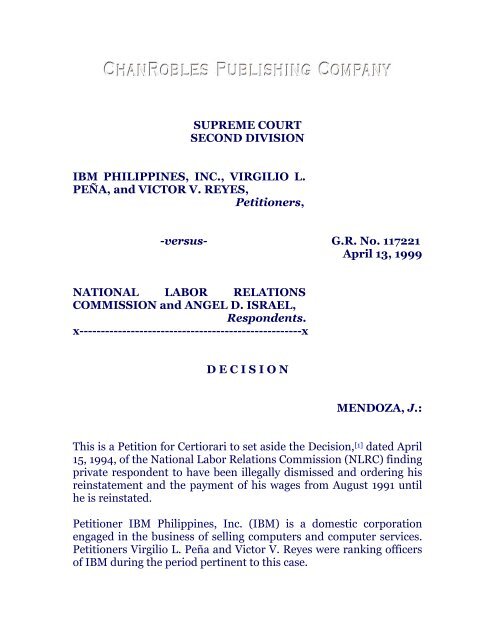
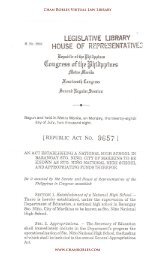
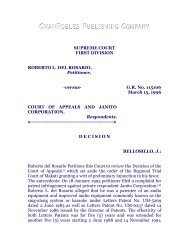
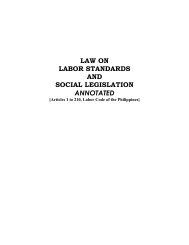
![Aurelio vs. NLRC, (221 SCRA 432 [1993]) - Chan Robles and ...](https://img.yumpu.com/51280528/1/190x245/aurelio-vs-nlrc-221-scra-432-1993-chan-robles-and-.jpg?quality=85)
